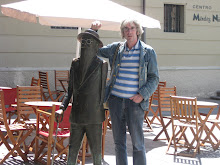It has been raining a bit in A Coruña today. Nothing unusual about that you might think. But when a fine drizzle (the famous Galician orballo) fell on the streets of A Coruña yesterday morning it was the first drop of rain for 17 days. In fact, since the start of October only 7 days have seen any rain.
I’ve been quite happy about that after last year's dreich autumn but it’s not good news for Spain as a whole. The country depends upon Galicia for much of its water supply. Last October it rained 22 days out of 31 in A Coruña.
Thursday, November 15, 2007
Wednesday, November 7, 2007
The English Cemetery
Recently a student lent me a book called Mar Tenebroso – A costa da morte do Sol – by Ramón Allegue Martínez and Ramón Allegue Barreiro. I’ve only had time to dip in and out of it but it touches on a topic I’d like to find out more about: the intertwining history and legends of the Costa da morte; so-called because it has been a graveyard for many ships over the years.
One of the best known of these was an English ship called The Serpent, which left Plymouth in choppy waters in November 1890. It was heading for South Africa with a cargo that included gold and armoury when it sank off Punta Boi with only 3 survivors out of a crew of 175.
When the bodies of the victims were washed ashore, they were said to have been plundered for clothes and jewels before other ships from both Spain and Britain arrived on the scene.
The victims were buried in a cemetery in Punta do Boi between Cape Vilán and Trece beach. It is known as the “Cementerio de los ingleses”. There is also a plaque in honour of these sailors in the San Carlos Gardens in A Coruña.
One of the best known of these was an English ship called The Serpent, which left Plymouth in choppy waters in November 1890. It was heading for South Africa with a cargo that included gold and armoury when it sank off Punta Boi with only 3 survivors out of a crew of 175.
When the bodies of the victims were washed ashore, they were said to have been plundered for clothes and jewels before other ships from both Spain and Britain arrived on the scene.
The victims were buried in a cemetery in Punta do Boi between Cape Vilán and Trece beach. It is known as the “Cementerio de los ingleses”. There is also a plaque in honour of these sailors in the San Carlos Gardens in A Coruña.
Subscribe to:
Comments (Atom)
